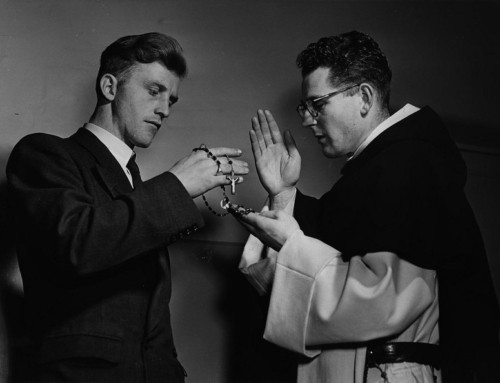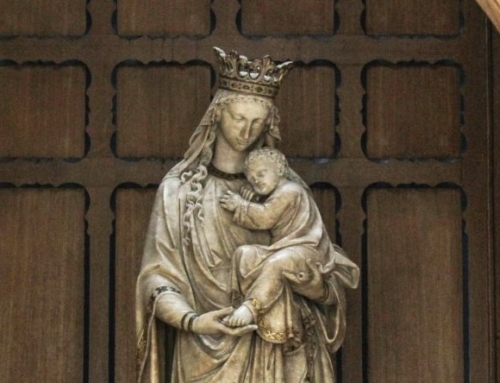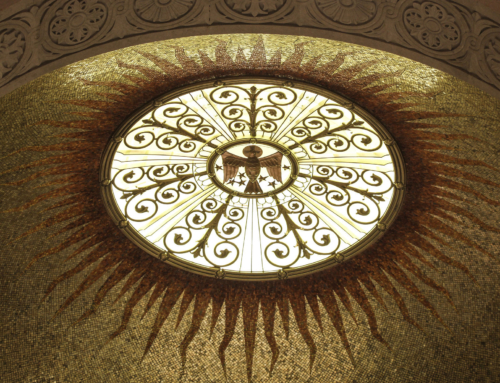Robert Cardinal Sarah with Nicolas Diat, The Power of Silence: Against the Dictatorship of Noise. San Francisco: Ignatius, 2017.
For ah! we know not what each other says,
These things and I; in sound I speak—
Their sound is but their stir, they speak by silences.
– Francis Thompson, The Hound of Heaven
After the death of Pope St. John Paul II in 2005, Joseph Cardinal Ratzinger addressed the conclave of cardinals, warning them that relativism is “letting oneself be tossed here and there, carried about by every wind of doctrine” (Eph 4:14). The clamor of competing ideas and beliefs push, pull, and tug on the ears of man, transforming him into a relativist separated from God. Over a decade later, in The Power of Silence, Robert Cardinal Sarah diagnoses the effects of relativism’s tyranny, which Ratzinger denounced in Pro Eligendo Romano Pontifice. He claims, “[man] gets drunk on all sorts of noises so as to forget who he is. Postmodern man seeks to anesthetize his own atheism” (229–230). In other words, the dictatorship of noise follows upon the dictatorship of relativism.
Hoping to reach these individuals in desperate need of salvation, Sarah writes with prophetic urgency. Paralleling Russian novelist Fyodor Dostoyevsky’s cry, “beauty will save the world,” Sarah himself cries, “Prayer and silence will save the world” (167).
Numbered paragraphs amounting to 365 organize the extensive interview conducted by French journalist Nicolas Diat. The numbering—not just a convenient reference tool—suggests a spiritual program: reflect daily on silence for one year. With over eighty works cited in his book—ranging from Church Fathers, to modern novelists, to eremitic monks—Sarah approaches the mystery of silence in a spiral. He returns to ideas, but always with an additional viewpoint and further depth. Sarah probes many subjects—the Cross, mystery, liturgy, evil, suffering, religious life, and the hiddenness of God—creating a broad reflection on silence. Each paragraph, or each day, provides one idea or thought varying in length from several pages to one sentence. The shortest idea appears near the end of the meditation: “Sickness is an anticipation of the silence of eternity” (182).
This succinct, recondite sentence—and the whole book—sprouts from Sarah’s friendship with a quiet, infirm canon unknown to the world but known to God. Brother Vincent-Marie of the Resurrection, a member of the Canons Regular of the Mother of God, suffered from multiple sclerosis silently in the Abbey of Sainte-Marie de Lagrasse in France. The disease had rendered him paralyzed, mute, and bedridden. Even his very breath became laborious. Diat’s introduction elaborates on the moving friendship between the canon and the cardinal, which grew in the midst of prayer, suffering, and silence. The two men visited with each other in the presence of God until Brother Vincent’s passing. Prior to that day, Sarah noted that his canon friend exhibited a paradoxical sign of hope: “Brother Vincent’s bloodshot eyes already had the brightness of eternity” (9).
The cardinal proclaims that the fruits of silence, prayer, and trust in God triumph over the trials of life and the violence of rebellion. Two horrors of life, natural devastation and human violence (natural and moral evil), require prayer, a silent turning toward God; other responses fall short. He claims that the rosary prayed by the Church and Pope St. John Paul II to Our Lady of Fatima brought down Marxist Communism (167). No political system or mere human action could do the same. (This is a timely reminder during the one-hundredth anniversary of the Fatima apparitions.)
The book begins with a description of a religious, a silent canon, enduring his cross away from the noise of the world. The book closes with another religious, a silent hermit enduring his cross in the French alps. Dom Dysmas de Lassus, prior of the Grande Chartreuse, opened the doors of the charterhouse for the interview, a rare accommodation and a fitting location for silence. In addition to sharing his abode, Dom Dysmas shares his wisdom. With clarity and concision, one of his analogies, using a familiar image, illustrates the silent presence of God within the soul:
During one annual visit of my family to the monastery, my sister was pregnant, and suddenly, in the middle of a conversation, she smiled a beautiful smile. Since the context did not explain it, I asked her: “Irene, why are you smiling?” She then answered me: “He is moving.” It was not necessary to ask who “he” was. (193)
The Power of Silence describes the immeasurable and irreplaceable importance of the interior life spent with God. Similar to his first book, God or Nothing, Sarah contrasts two ends that man may choose: exterior noise or interior silence. If man looks outward for power, rebellion ensues. If man turns inward, he discovers the silent presence of God within the soul. This silence requires more than quiet, the absence of exterior noise. Sarah speaks of an interior silence void of disruptive passions and preoccupations. This silence comes from a solitude, but not a solitude which is the mere absence of others. There is a solitude found in communion with God, God alone and alone with God. We see the choices: silence or rebellion, reality or fantasy, communion or isolation, God or nothing. In this communion, this interior silence, one finds meaning and purpose in life by praising God. Sarah writes, “True life is not in rebellion but in silent adoration” (173).
✠
Download a PDF of this review here.



